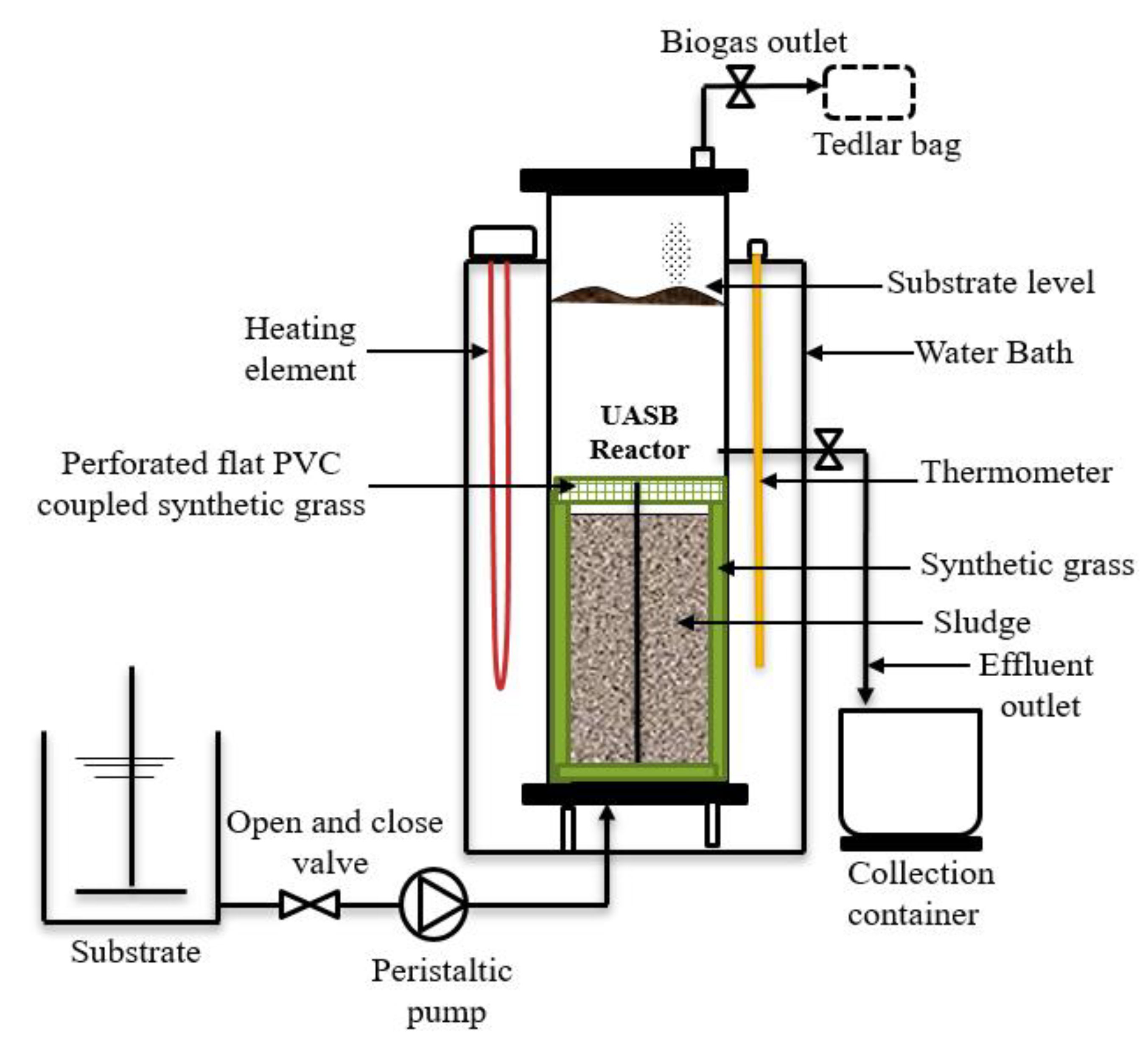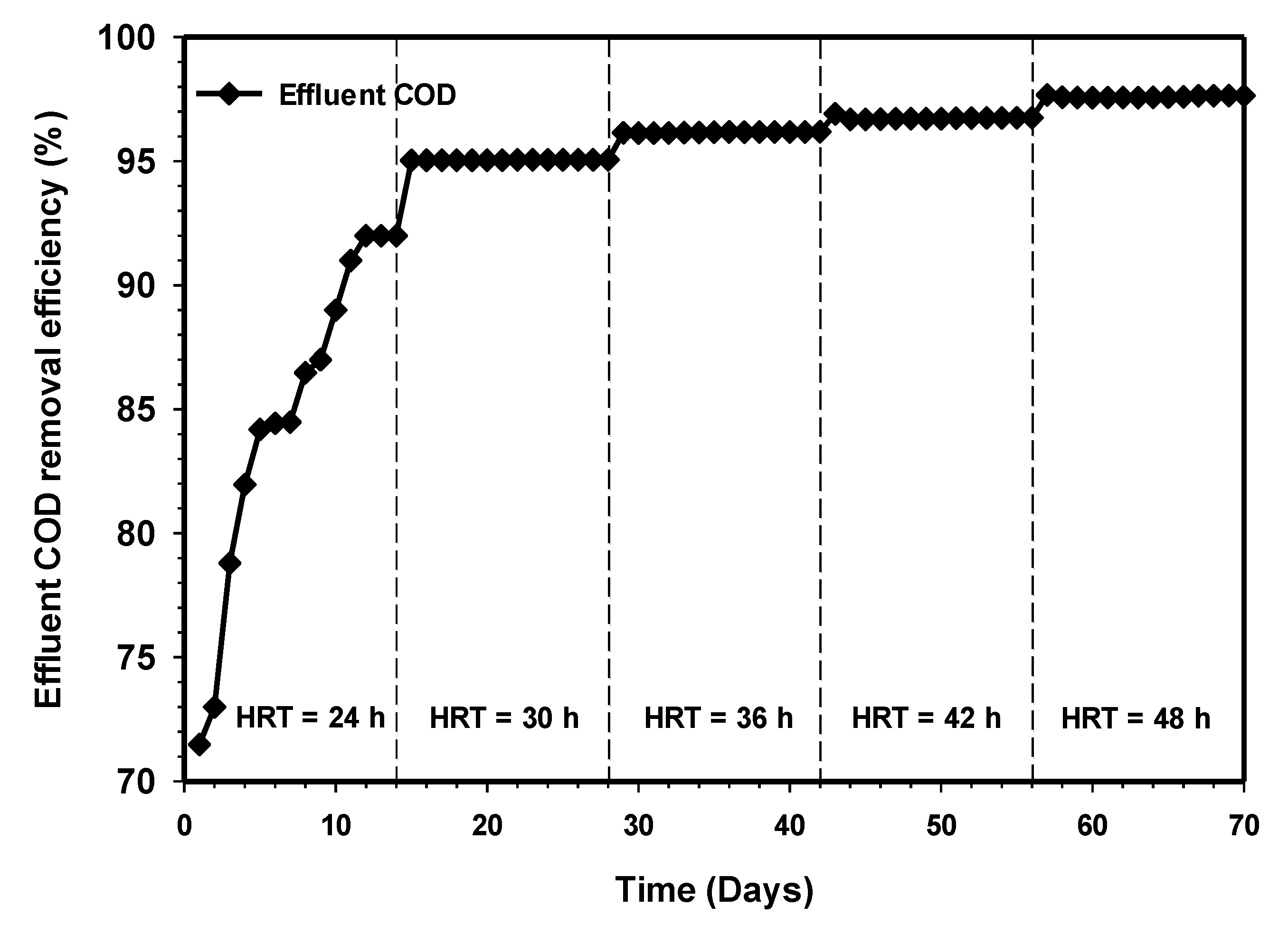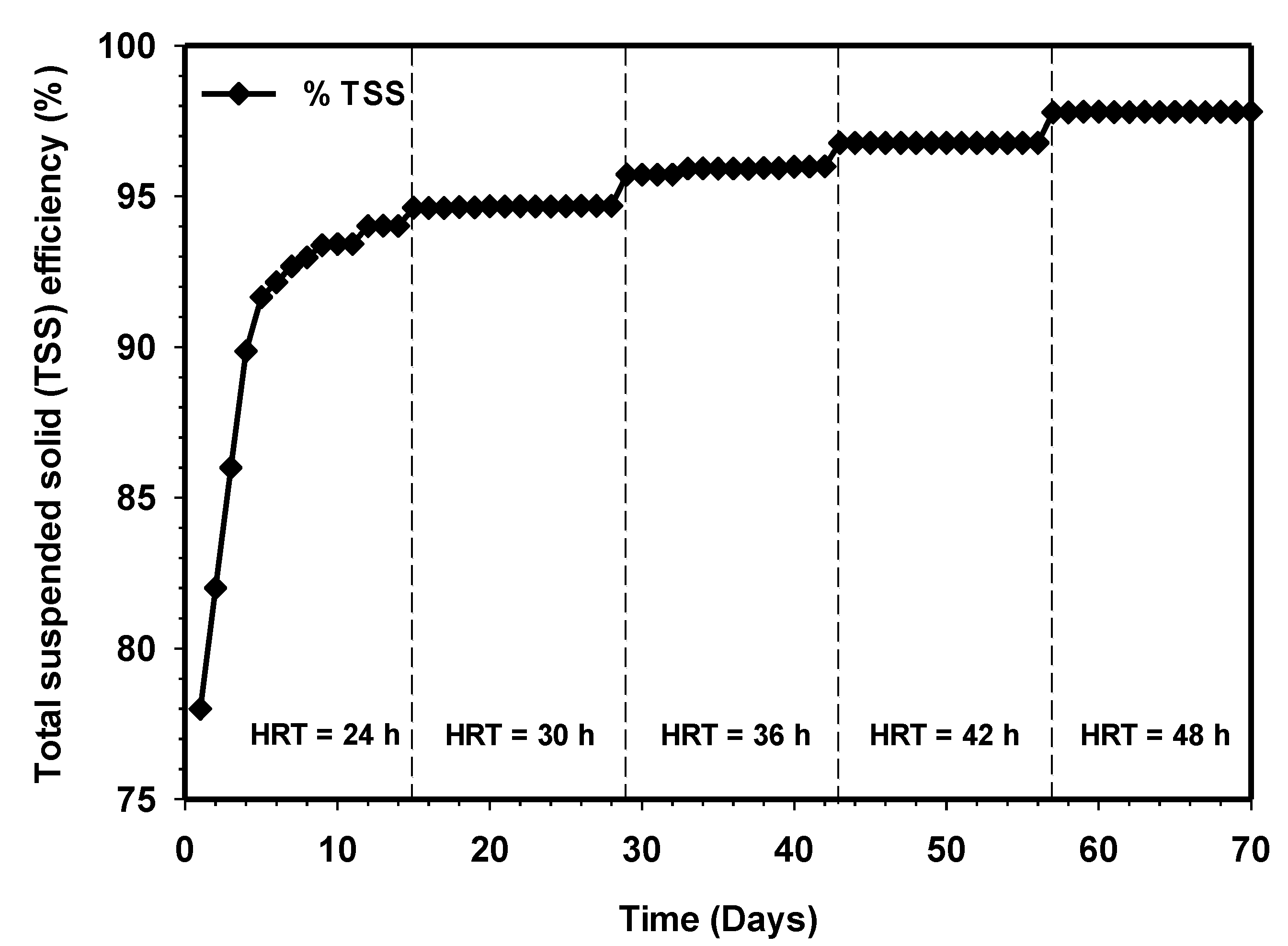Effect of Hydraulic Retention Time on the Treatment of Real Cattle Slaughterhouse Wastewater and Biogas Production from HUASB Reactor
Abstract
:1. Introduction
2. Materials and Methods
2.1. Cattle Slaughterhouse Wastewater
2.2. Characterization of the Wastewater
2.3. Experimental Setup
2.4. Acclimatization of the Seed Sludge
2.5. Continuous Study Operation Condition
2.6. Analytical Methods
3. Results and Discussion
3.1. Performance of HUASB Reactor during the Acclimatization Period
3.2. Effect of Increasing HRT on Biogas Production from the HUASB Reactor
3.3. Effect of Increasing HRT on the COD Removal Efficiency
3.4. Effect of Increasing HRT on TSS and VSS Removals
3.5. Effect of Increasing HRT on the Effluent pH and Alkalinity Ratio of HUASB Reactor
3.6. Effect of Increasing HRT on the Ammonia Nitrogen Production
3.7. Effect of Increasing HRT on the Fats, Oil, and Grease Removal
3.8. Effect of Increasing HRT on the Color Removal and Turbidly from the Effluent
3.9. Scanning Electron Microscopy (SEM) Analysis of R2 after Increasing Contact Time
4. Conclusions
Author Contributions
Funding
Acknowledgments
Conflicts of Interest
References
- Flores-Juarez, C.R.; Rodríguez-García, A.; Cárdenas-Mijangos, J.; Montoya-Herrera, L.; Arturo Godinez Tovar, L.; Bustos Bustos, E.; Rodríguez-Valadez, F.; Manríquez-Rocha, J. Chemically pretreating slaughterhouse solid waste to increase the efficiency of anaerobic digestion. J. Biosci. Bioeng. 2014, 118, 415–419. [Google Scholar] [CrossRef] [PubMed]
- Aryal, N.; Kvist, T. Alternative of Biogas Injection into the Danish Gas Grid System-A Study from Demand Perspective. Chem. Eng. 2018, 2, 43. [Google Scholar] [CrossRef] [Green Version]
- Delre, A.; Mønster, J.; Scheutz, C. Greenhouse gas emission quantification from wastewater treatment plants, using a tracer gas dispersion method. Sci. Total Environ. 2017, 605–606, 258–268. [Google Scholar] [CrossRef] [PubMed] [Green Version]
- Eeddy, M.; Tchobanoglous, G. Wastewater Engineering—Treatment and Reuse; McGraw-Hill: New York, NY, USA, 2004. [Google Scholar]
- US EPA. Technical Development Document for the Final Effluent Limitations Guidelines and Standards for the Meat and Poultry Products Point Source Category (40 CFR 432); US EPA: Washington, DC, USA, 2004; p. 61.
- Rajab, A.R.; Salim, M.R.; Sohaili, J.; Anuar, A.N.; Salmiati; Lakkaboyana, S.K. Performance of integrated anaerobic/aerobic sequencing batch reactor treating poultry slaughterhouse wastewater. Chem. Eng. J. 2017, 313, 967–974. [Google Scholar] [CrossRef]
- Johns, M.R.; Harrison, M.L.; Hutchinson, P.H.; Beswick, P. Sources of nutrients in wastewater from integrated cattle slaughterhouses. Water Sci. Technol. 1995, 32, 53–58. [Google Scholar] [CrossRef]
- Kraus, G.A. Alternatives to Conventional Food Processing; Royal Society of Chemistry: London, UK, 2017. [Google Scholar]
- Jing, Z.; Hu, Y.; Niu, Q.; Liu, Y.; Li, Y.Y.; Wang, X.C. UASB performance and electron competition between methane-producing archaea and sulfate-reducing bacteria in treating sulfate-rich wastewater containing ethanol and acetate. Bioresour. Technol. 2013, 137, 349–357. [Google Scholar] [CrossRef]
- Carrillo-Reyes, J.; Celis, L.B.; Alatriste-Mondragón, F.; Razo-Flores, E. Decreasing methane production in hydrogenogenic UASB reactors fed with cheese whey. Biomass Bioenergy 2014, 63, 101–108. [Google Scholar] [CrossRef]
- Fang, C.; Boe, K.; Angelidaki, I. Biogas production from potato-juice, a by-product from potato-starch processing, in upflow anaerobic sludge blanket (UASB) and expanded granular sludge bed (EGSB) reactors. Bioresour. Technol. 2011, 102, 5734–5741. [Google Scholar] [CrossRef]
- Ahmad, A.; Ghufran, R.; Wahid, Z.A. Role of calcium oxide in sludge granulation and methanogenesis for the treatment of palm oil mill effluent using UASB reactor. J. Hazard. Mater. 2011, 198, 40–48. [Google Scholar] [CrossRef]
- Lu, X.; Ni, J.; Zhen, G.; Kubota, K.; Li, Y.Y. Response of morphology and microbial community structure of granules to influent COD/SO42− ratios in an upflow anaerobic sludge blanket (UASB) reactor treating starch wastewater. Bioresour. Technol. 2018, 256, 456–465. [Google Scholar] [CrossRef]
- Lu, X.; Zhen, G.; Ni, J.; Hojo, T.; Kubota, K.; Li, Y.Y. Effect of influent COD/SO42- ratios on biodegradation behaviors of starch wastewater in an upflow anaerobic sludge blanket (UASB) reactor. Bioresour. Technol. 2016, 214, 175–183. [Google Scholar] [CrossRef]
- Claudia, E.T.; Cammarota, M.C.; Alcina, M.F.X. Slaughterhouse wastewater treatment: Evaluation of a new three-phase separation system in a UASB reactor. Bioresour. Technol. 2002, 81, 61–69. [Google Scholar] [CrossRef]
- APHA. Standard Methods for the Examination of Water and Wastewater; American Public Health Association/American Water Works Association/Water Environment Federation: Washington, DC, USA, 2005. [Google Scholar]
- Rosli, N.S.; Idrus, S.; Nick, D.N.; Ahsan, A. Assessment of potential biogas production from rice straw leachate in upflow anaerobic sludge blanket reactor. Int. J. Smart Grid Clean Energy 2016, 5, 135–143. [Google Scholar] [CrossRef] [Green Version]
- Nicolella, C.; Van Loosdrecht, M.C.M.; Heijnen, J.J. Wastewater treatment with particulate biofilm reactors. J. Biotechnol. 2000, 80, 1–33. [Google Scholar] [CrossRef]
- Cao, Y.S.; Zhang, H.; Li, Y.Z. USAB treatment of monosodium glutamate wastewater; Dynamic and kinetic behaviour of the start-up of the reactor. Water Sci. Technol. 1992, 26, 2441–2444. [Google Scholar] [CrossRef]
- Cuetos, M.J.; Gómez, X.; Otero, M.; Morán, A. Anaerobic digestion of solid slaughterhouse waste (SHW) at laboratory scale: Influence of co-digestion with the organic fraction of municipal solid waste (OFMSW). Biochem. Eng. J. 2008, 40, 99–106. [Google Scholar] [CrossRef]
- Halalsheh, M.; Koppes, J.; Den Elzen, J.; Zeeman, G.; Fayyad, M.; Lettinga, G. Effect of SRT and temperature on biological conversions and the related scum-forming potential. Water Res. 2005, 39, 2475–2482. [Google Scholar] [CrossRef]
- Appels, L.; Van Assche, A.; Willems, K.; Degrève, J.; Van Impe, J.; Dewil, R. Peracetic acid oxidation as an alternative pre-treatment for the anaerobic digestion of waste activated sludge. Bioresour. Technol. 2011, 102, 4124–4130. [Google Scholar] [CrossRef]
- Ramírez-Sáenz, D.; Zarate-Segura, P.B.; Guerrero-Barajas, C.; García-Peña, E.I. H2S and volatile fatty acids elimination by biofiltration: Clean-up process for biogas potential use. J. Hazard. Mater. 2009, 163, 1272–1281. [Google Scholar] [CrossRef]
- Song, Y.C.; Kwon, S.J.; Woo, J.H. Mesophilic and thermophilic temperature co-phase anaerobic digestion compared with single-stage mesophilic- and thermophilic digestion of sewage sludge. Water Res. 2004, 38, 1653–1662. [Google Scholar] [CrossRef]
- Yenigün, O.; Demirel, B. Ammonia inhibition in anaerobic digestion: A review. Process Biochem. 2013, 48, 901–911. [Google Scholar] [CrossRef]
- Whelan, M.J.; Everitt, T.; Villa, R. A mass transfer model of ammonia volatilisation from anaerobic digestate. Waste Manag. 2010, 30, 1808–1812. [Google Scholar] [CrossRef] [PubMed]
- Kim, D.H.; Oh, S.E. Continuous high-solids anaerobic co-digestion of organic solid wastes under mesophilic conditions. Waste Manag. 2011, 31, 1943–1948. [Google Scholar] [CrossRef] [PubMed]
- Walker, M.; Iyer, K.; Heaven, S.; Banks, C.J. Ammonia removal in anaerobic digestion by biogas stripping: An evaluation of process alternatives using a first order rate model based on experimental findings. Chem. Eng. J. 2011, 178, 138–145. [Google Scholar] [CrossRef] [Green Version]
- Wang, X.; Yang, G.; Feng, Y.; Ren, G.; Han, X. Optimizing feeding composition and carbon-nitrogen ratios for improved methane yield during anaerobic co-digestion of dairy, chicken manure and wheat straw. Bioresour. Technol. 2012, 120, 78–83. [Google Scholar] [CrossRef] [PubMed]
- Gerardi, M.H. The Microbiology of Anaerobic Digester; John Wiley & Sons, Inc.: Hoboken, NJ, USA, 2003; Volume 111, p. 479. [Google Scholar] [CrossRef]
- Shanmugam, P.; Horan, N.J. Optimising the biogas production from leather fleshing waste by co-digestion with MSW. Bioresour. Technol. 2009, 100, 4117–4120. [Google Scholar] [CrossRef] [PubMed]
- Karlsson, A.; Ejlertsson, J. Addition of HCl as a means to improve biogas production from protein-rich food industry waste. Biochem. Eng. J. 2012, 61, 43–48. [Google Scholar] [CrossRef]
- Girault, R.; Bridoux, G.; Nauleau, F.; Poullain, C.; Buffet, J.; Peu, P.; Sadowski, A.G.; Béline, F. Anaerobic co-digestion of waste activated sludge and greasy sludge from flotation process: Batch versus CSTR experiments to investigate optimal design. Bioresour. Technol. 2012, 105, 1–8. [Google Scholar] [CrossRef] [Green Version]
- Long, J.H.; Aziz, T.N.; Reyes, F.L.d.L.; Ducoste, J.J. Anaerobic co-digestion of fat, oil, and grease (FOG): A review of gas production and process limitations. Process Saf. Environ. Prot. 2012, 90, 231–245. [Google Scholar] [CrossRef]
- Abass, O.A.; Jameel, A.T.; Muyubi, S.A.; Abdul Karim, M.I.; Alam, A.Z.M. Removal of Oil and Grease as Emerging Pollutants of Concern (EPC) in Wastewater Stream. IIUM Eng. J. 2011, 12, 161–169. [Google Scholar] [CrossRef]
- León-Becerril, E.; García-Camacho, J.E.; Del Real-Olvera, J.; López-López, A. Performance of an upflow anaerobic filter in the treatment of cold meat industry wastewater. Process Saf. Environ. Prot. 2016, 102, 385–391. [Google Scholar] [CrossRef]
- Department of Environment Ministry of Natural Resources and Environment Wisma Sumber Asli. Environmental Requirements: A Guide For. Investors, 11th ed.; Federal Government Administrative Centre: Putrajaya, Malaysia, 2010.
- Yetilmezsoy, K.; Ilhan, F.; Sapci-Zengin, Z.; Sakar, S.; Gonullu, M.T. Decolorization and COD reduction of UASB pretreated poultry manure wastewater by electrocoagulation process: A post-treatment study. J. Hazard. Mater. 2009, 162, 120–132. [Google Scholar] [CrossRef] [PubMed]
- Conklin, A.; Stensel, H.D.; Ferguson, J. Growth kinetics and competition between Methanosarcina and Methanosaeta in mesophilic anaerobic digestion. Water Environ. Res. 2006, 78, 486–496. [Google Scholar] [CrossRef]
- Qu, X.; Vavilin, V.A.; Mazéas, L.; Lemunier, M.; Duquennoi, C.; He, P.J.; Bouchezb, T. Anaerobic biodegradation of cellulosic material: Batch experiments and modelling based on isotopic data and focusing on aceticlastic and non-aceticlastic methanogenesis. Waste Manag. 2009, 29, 1828–1837. [Google Scholar] [CrossRef] [PubMed]
- De Vrieze, J.; Hennebel, T.; Boon, N.; Verstraete, W. Methanosarcina: The rediscovered methanogen for heavy duty biomethanation. Bioresour. Technol. 2012, 112, 1–9. [Google Scholar] [CrossRef] [PubMed]
- Ziganshin, A.M.; Schmidt, T.; Scholwin, F.; Il’Inskaya, O.N.; Harms, H.; Kleinsteuber, S. Bacteria and archaea involved in anaerobic digestion of distillers grains with solubles. Appl. Microbiol. Biotechnol. 2011, 89, 2039–2052. [Google Scholar] [CrossRef]
- Acharya, B.K.; Pathak, H.; Mohana, S.; Shouche, Y.; Singh, V.; Madamwar, D. Kinetic modelling and microbial community assessment of anaerobic biphasic fixed film bioreactor treating distillery spent wash. Water Res. 2011, 45, 4248–4259. [Google Scholar] [CrossRef]
- Wijekoon, K.C.; Visvanathan, C.; Abeynayaka, A. Effect of organic loading rate on VFA production, organic matter removal and microbial activity of a two-stage thermophilic anaerobic membrane bioreactor. Bioresour. Technol. 2011, 102, 5353–5360. [Google Scholar] [CrossRef]
- Sasaki, K.; Haruta, S.; Ueno, Y.; Ishii, M.; Igarashi, Y. Microbial population in the biomass adhering to supporting material in a packed-bed reactor degrading organic solid waste. Appl. Microbiol. Biotechnol. 2007, 75, 941–952. [Google Scholar] [CrossRef]














| Parameters | Unit | Average Value |
|---|---|---|
| COD | mg/L | 32,000 ± 112 |
| BOD5 | mg/L | 17,158 ± 95 |
| TSS | mg/L | 22,300 ± 212 |
| VSS | mg/L | 18,924 ± 318 |
| TN | mg/L | 1865 ± 18 |
| PO43- | mg/L | 49 ± 2 |
| Protein | mg/L | 11,637.6 ± 18 |
| NH3-N | mg/L | 38 ± 1 |
| FOG | mg/L | 1024 ± 34 |
| Alkalinity | mg/L as CaCO3 | 582 ± 14 |
| pH | - | 6.9 ± 0.8 |
| Temperature | °C | 27.6± 0.5 |
| Color | Pt-Co | 16,426.8 ± 334 |
| Turbidity | FAU | 12,500 ± 76 |
| Materials | Quantity | Unit |
|---|---|---|
| Yeast (granular form) | 23 | g |
| Urea | 2 | g |
| Sugar | 11.5 | g |
| Ammonium phosphate (NH4)2HPO4 | 3.4 | g |
| Full cream | 144 | mL |
| Raw blood from cattle slaughterhouse | 5.75 | mL |
| Tap water | Full to 1 L |
| Run | Duration (Days) | Influent COD (g L−1) | HRT (h) | pH |
|---|---|---|---|---|
| I. | 14 | 20 | 24 | 7.2 |
| II. | 14 | 20 | 30 | 7.4 |
| III. | 14 | 20 | 30 | 7.2 |
| IV. | 14 | 20 | 42 | 7.1 |
| V. | 14 | 20 | 48 | 7.3 |
| Run | Duration (Days) | Influent COD (g L−1) | HRT (h) | Biogas (L/d) | (%) Methane | COD (%) | SMP (LCH4/gCODadded) | pH | Alkalinity Ratio (IA/PA) | NH3-N (mg/L) | TSS (%) | VSS (mg/L) | FOG (%) | Color (Pt/Co) | Turbidity (FAU) |
|---|---|---|---|---|---|---|---|---|---|---|---|---|---|---|---|
| I. | 14 | 20 | 24 | 27 | 84 | 92 | 0.2 | 6.9 | 0.16 | 414 | 94 | 521 | 53.9 | 62 | 74 |
| II. | 14 | 20 | 30 | 29 | 77 | 95 | 0.21 | 6.8 | 0.15 | 452 | 94 | 401 | 64 | 69 | 84 |
| III. | 14 | 20 | 36 | 32 | 81 | 96 | 0.24 | 7.1 | 0.18 | 565 | 95 | 355 | 71 | 73 | 84.9 |
| IV. | 14 | 20 | 42 | 33 | 82 | 96.7 | 0.24 | 7.2 | 0.22 | 663 | 96 | 345 | 73 | 74 | 85 |
| V. | 14 | 20 | 48 | 38 | 86 | 97.6 | 0.26 | 7.2 | 0.22 | 839 | 97 | 285 | 79 | 78 | 91 |
© 2020 by the authors. Licensee MDPI, Basel, Switzerland. This article is an open access article distributed under the terms and conditions of the Creative Commons Attribution (CC BY) license (http://creativecommons.org/licenses/by/4.0/).
Share and Cite
Musa, M.A.; Idrus, S. Effect of Hydraulic Retention Time on the Treatment of Real Cattle Slaughterhouse Wastewater and Biogas Production from HUASB Reactor. Water 2020, 12, 490. https://doi.org/10.3390/w12020490
Musa MA, Idrus S. Effect of Hydraulic Retention Time on the Treatment of Real Cattle Slaughterhouse Wastewater and Biogas Production from HUASB Reactor. Water. 2020; 12(2):490. https://doi.org/10.3390/w12020490
Chicago/Turabian StyleMusa, Mohammed Ali, and Syazwani Idrus. 2020. "Effect of Hydraulic Retention Time on the Treatment of Real Cattle Slaughterhouse Wastewater and Biogas Production from HUASB Reactor" Water 12, no. 2: 490. https://doi.org/10.3390/w12020490
APA StyleMusa, M. A., & Idrus, S. (2020). Effect of Hydraulic Retention Time on the Treatment of Real Cattle Slaughterhouse Wastewater and Biogas Production from HUASB Reactor. Water, 12(2), 490. https://doi.org/10.3390/w12020490





